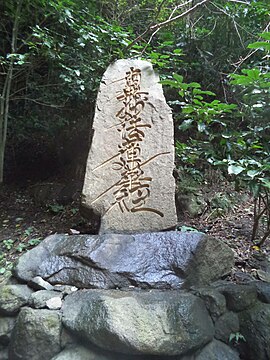Namu Myōhō Renge Kyō
Namu Myōhō Renge Kyō ( Japanese 南 無 妙法 蓮華 経 ), with the honorary prefix Namu , as O-daimoku (お 題目) or in its short form, Nam Myōhō Renge Kyō as daimoku (Japanese 題目 ) is the central mantra and the basic practice in Nichiren Buddhism .
"Myōhō Renge Kyō" is the Sino-Japanese pronunciation of the title of the Lotus Sutra . The "Namu" ( 南 無 ; the "u" is mostly heard in the Nichiren Shū tradition, in the Nichiren Shōshū tradition, on the other hand, it is partially silent in pronunciation and completely silent in Sōka Gakkai ) is a Buddhist term , which simultaneously means praise, dedication and the affirmation of faith and occurs in many Buddhist formulas (such as the Nembutsu ), comparable to the Judeo-Christian amen . For the Japanese monk and scholar Nichiren (1222-1282), however, these five syllables of Myō-Hō-Ren-Ge-Kyō represented the essence of the Lotus Sutra and the teachings of Shakyamuni Buddha as a whole. For Nichiren, therefore, reciting this mantra was almost to be equated with the recitation of the entire Lotus Sutra and is thus intended to reinforce the belief in the teachings of Shakyamuni Buddhas.
The daimoku is at the center of the Gohonzon , the mandala in Nichiren Buddhism, and, along with this and the ordination platform ( kaidan ), belongs to the "Three Great Secret Dharmas" ( : 秘 法 , sandai-hihō ; these are: 本 門 の 本尊 , honmon no honzon ; 本 門 の 戒壇 , honmon no kaidan ; 本 門 の 題目 , honmon no daimoku ), it is always part of the so-called Gongyō or Shōdaigyō .
By reciting the daimoku ( 唱題 , Shodai) which basically exists in every human being to Buddha nature are manifested and the faithful already in this life the Buddha are.
translation
A translation of this mantra is difficult to formulate aptly, which can be clarified by an explanation of the individual components:
- Namu ( 南 無 ) is a Sanskrit (Namas) word that is root-related to the German word "haben" (meaning to grasp or hold on). It can be translated as “I dedicate myself” or “I seek refuge”. This word is also known from the greeting " Namaste " ( Sanskrit नमस्ते नमस्त ) or "Namaskar", which is often used by Buddhists . In Amitabha Buddhism , this word can be found, for example, in the mantra " Namu Amida Butsu " ( 南 無 阿彌陀佛 ).
- Myō-hō ( 妙法 ) can be translated as "true law ( Dharma )" or "wonderful law". Another meaning of Myō is also "mystical" and thus stands for the invisible, incomprehensible aspects of life, whereas hō (law, Dharma) stands for the parts that manifest themselves. Nichiren is also said to have explained Myōhō as "opening up" and "perfectly equipped".
- Renge ( 蓮華 ) means lotus plant . It is a symbol of the simultaneity of cause and effect, since it bears fruit and blossom at the same time. It also stands for purity in the midst of impurity. Its always clean flowers and leaves (see lotus effect ) symbolize Buddhahood, and as a swamp or water plant, it needs the mud and mud, which stands for the impurities and adversities of life, in order to grow at all.
- Kyō ( 経 ) stands for Sutra . The Buddhist scriptures, which have the teachings of Shakyamuni as their content, are commonly referred to as sutra.
By adding “Nam (u)” this mantra could be translated as “I dedicate myself to the wonderful Dharma of the Lotus Sutra” or “I dedicate myself to the mystical law of cause and effect” or “Praise be to the wonderful Lotus Sutra! " translate. Ultimately, however, these are only translation approaches, as the various Nichiren schools give different weightings to meanings and interpretations.
literature
- Shoryo Tarabini: Odaimoku: The Significance Of Chanting Namu Myoho Renge Kyo . Renkoji Editions, Cereseto / lulu.com, 2011, ISBN 978-1447736578
- Richard Causton: The Everyday Buddha: Introduction to Nichiren Daishonin's Buddhism . SGI-D, Mörfelden-Walldorf, 1998 ISBN 978-3-937615-02-8
- Daisaku Ikeda : The Book of Happiness: How to Live More Joyfully with Buddhist Insights . Nymphenburger0 Munich, 2005, ISBN 3-485-01057-X
- Lotus Seeds: The Essence Of Nichiren Shu Buddhism . Nichiren Buddhist Temple of San Jose, 2000, ISBN 0970592000
- Yukio Matsudo: Nichiren, the practitioner of the Lotus Sutra . Books on Demand 2009; ISBN 3837091937
- Jay Sakashita (Ed.): The Writings of Nichiren Shonin , Volumes 1-4. University of Hawai'i Press, Honolulu / Eurospan, London, 2003, ISBN 0824827333
- A Dictionary of Buddhist Terms and Concepts . Nichiren Shoshu International Center, Tokyo, 1983, ISBN 4888720142
- Jacqueline I. Stone: Chanting the August Title of the Lotus Sutra: Daimoku Practices in Classical and Medieval Japan . In: Richard K. Payne (Ed.): Re-Visioning Kamakura Buddhism . University of Hawaii Press, Honolulu, 1998, ISBN 0-8248-2078-9 , pp. 116-166.
